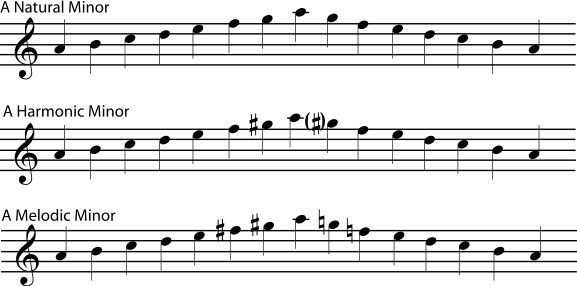In the last post, we saw how to create Chromatic and Diatonic Scales, but we only discussed major diatonic scales. Minor scales are closely related to the Major scales and they can be either Relative Minor [ sharing the same key signature] or Parallel Minor [sharing the same starting note or tonic].
Before we dive into the Minor Keys, it’s important to understand how the Chromatic and Diatonic Scales work. Chromatic Scales lend themselves to borrowed chords, accidentals and these scales go outside of the key. On the contrary, Diatonic Keys stay strictly within the key with no added sharps or flats.
Minor Scale Construction
Minor Scales begin on the 6th degree of a scale which is identified as the submediant – or the Aeolian Mode. The Natural Minor follows the pattern of the Parallel Major Scale except for the fact that it starts on the 6th degree. i.e. C Major has C, D, E, F, G, A, and B, while its Relative Minor Scale – A minor – has A, B, C, D, E, F, and G. All the notes are the same pitch class. The Minor Scales differ from their Parallel Major counterparts specifically on the 3rd, 6th, and 7th scale degrees which are all flattened. The Natural Minor has NO LEADING TONE.
The Harmonic Minor Scale follows the exact same pattern, but the 7th degree is raised. In a sense, you get the best of both worlds with the minor qualities and a raised 7th which lends itself to better harmonies since the leading tone now is where it should be – a half step away from the tonic again – and regains its special characteristic of “leading” you to the note above it. The raised 7th also now makes the dominant chord Major.
The Melodic Minor Scale raises the 6th and 7th degrees of the scale on its ascent and the Natural Minor Scale is employed on the descent.

When an arrangement employs a Minor Scale it is normal for all of the different forms of the minor scale to be used at one point or the other.
Finding the Keys

To find the Relative Major of any key, identify the 3rd above the tonic and lower it by a semitone. To find the Relative Minor of any key, you would find the 6th note going up or the third note descending from the tonic. A good way to spot a minor key is that it has accidentals. You can identify Minor keys aurally by listening to the quality of the third – the third will be flattened in a Minor Scale.
Songs in Minor Keys
Autumn Leaves is a popular jazz standard in a minor Key. This version is in concert Emin but the performance is transposed to concert Dmin.
In bars 3 and 5 the Natural Minor form of E minor is used and in bar 7 the Melodic Minor form is used. Bar 5 has C natural and D natural leading to E natural forming whole tone intervals while both of these tones are raised in bar 7 giving us C# and D# – the tones we would normally see in an E Major scale on the 6th and 7th degrees.

